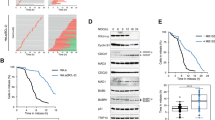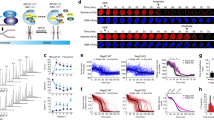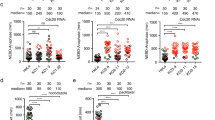Abstract
The anaphase-promoting complex/cyclosome (APC/C) is a ubiquitin ligase that initiates anaphase and mitotic exit. APC/C is activated by Cdc20 and inhibited by the mitotic checkpoint complex (MCC), which delays mitotic exit when the spindle assembly checkpoint (SAC) is activated. We previously identified apcin as a small molecule ligand of Cdc20 that inhibits APC/CCdc20 and prolongs mitosis. Here we find that apcin paradoxically shortens mitosis when SAC activity is high. These opposing effects of apcin arise from targeting of a common binding site in Cdc20 required for both substrate ubiquitination and MCC-dependent APC/C inhibition. Furthermore, we found that apcin cooperates with p31comet to relieve MCC-dependent inhibition of APC/C. Apcin therefore causes either net APC/C inhibition, prolonging mitosis when SAC activity is low, or net APC/C activation, shortening mitosis when SAC activity is high, demonstrating that a small molecule can produce opposing biological effects depending on regulatory context.

This is a preview of subscription content, access via your institution
Access options
Access Nature and 54 other Nature Portfolio journals
Get Nature+, our best-value online-access subscription
$29.99 / 30 days
cancel any time
Subscribe to this journal
Receive 12 print issues and online access
$259.00 per year
only $21.58 per issue
Buy this article
- Purchase on Springer Link
- Instant access to full article PDF
Prices may be subject to local taxes which are calculated during checkout






Similar content being viewed by others
Data availability
Raw data associated with Figs. 1a–e, 2b,c, 3a,b, 4b, 5a,d,f and 6b–e are available from the corresponding author upon reasonable request. All MS data generated during this study have been deposited to the ProteomeXchange Consortium via the PRIDE56 partner repository with dataset identifier PXD013786.
Code availability
MATLAB code used to calculate mitotic fraction is available upon request from the corresponding author.
References
Peters, J. The anaphase promoting complex/cyclosome: a machine designed to destroy. Nat. Rev. Mol. Cell Biol. 7, 644–656 (2006).
Alfieri, C., Zhang, S. & Barford, D. Visualizing the complex functions and mechanisms of the anaphase promoting complex/cyclosome (APC/C). Open Biol. 7, 170204 (2017).
Watson, E. R., Brown, N. G., Peters, J. M., Stark, H. & Schulman, B. A. Posing the APC/C E3 ubiquitin ligase to orchestrate cell division. Trends Cell Biol. 29, 117–134 (2019).
Musacchio, A. & Salmon, E. D. The spindle-assembly checkpoint in space and time. Nat. Rev. Mol. Cell Biol. 8, 379–393 (2007).
Liu, S.-T. & Zhang, H. The mitotic checkpoint complex (MCC): looking back and forth after 15 years. AIMS Mol. Sci. 3, 597–634 (2016).
Izawa, D. & Pines, J. The mitotic checkpoint complex binds a second CDC20 to inhibit active APC/C. Nature 517, 631–634 (2015).
Alfieri, C. et al. Molecular basis of APC/C regulation by the spindle assembly checkpoint. Nature 536, 431–436 (2016).
Yamaguchi, M. et al. Cryo-EM of mitotic checkpoint complex-bound APC/C reveals reciprocal and conformational regulation of ubiquitin ligation. Mol. Cell 63, 593–607 (2016).
Di Fiore, B., Wurzenberger, C., Davey, N. E. & Pines, J. The mitotic checkpoint complex requires an evolutionary conserved cassette to bind and inhibit active APC/C. Mol. Cell 64, 1144–1153 (2016).
Burton, J. L. & Solomon, M. J. Mad3p, a pseudosubstrate inhibitor of APCCdc20 in the spindle assembly checkpoint. Genes Dev. 21, 655–667 (2007).
Sewart, K. & Hauf, S. Different functionality of Cdc20 binding sites within the mitotic checkpoint complex. Curr. Biol. 27, 1213–1220 (2017).
Verma, R. Ubistatins inhibit proteasome-dependent degradation by binding the ubiquitin chain. Science 306, 117–120 (2004).
Zeng, X. et al. Pharmacologic inhibition of the anaphase-promoting complex induces a spindle checkpoint-dependent mitotic arrest in the absence of spindle damage. Cancer Cell 18, 382–395 (2010).
Zeng, X. & King, R. W. An APC/C inhibitor stabilizes cyclin B1 by prematurely terminating ubiquitination. Nat. Chem. Biol. 8, 383–392 (2012).
Sackton, K. L. et al. Synergistic blockade of mitotic exit by two chemical inhibitors of the APC/C. Nature 514, 646–649 (2014).
Zhang, S. et al. Molecular mechanism of APC/C activation by mitotic phosphorylation. Nature 533, 260–264 (2016).
Kung, A. L., Sherwood, S. W. & Schimke, R. T. Cell line-specific differences in the control of cell cycle progression in the absence of mitosis. Proc. Natl Acad. Sci. USA 87, 9553–9557 (1990).
Andreassen, P. R. & Margolis, R. L. Microtubule dependency of p34cdc2 inactivation and mitotic exit in mammalian cells. J. Cell Biol. 127, 789–802 (1994).
Brito, D. A. & Rieder, C. L. Mitotic checkpoint slippage in humans occurs via cyclin B destruction in the presence of an active checkpoint. Curr. Biol. 16, 1194–1200 (2006).
Gascoigne, K. E. & Taylor, S. S. Cancer cells display profound intra- and interline variation following prolonged exposure to antimitotic drugs. Cancer Cell 14, 111–122 (2008).
Huang, H., Shi, J., Orth, J. D. & Mitchison, T. J. Evidence that mitotic exit is a better cancer therapeutic target than spindle assembly. Cancer Cell 16, 347–358 (2009).
Manchado, E. et al. Targeting mitotic exit leads to tumor regression in vivo: modulation by Cdk1, Mastl, and the PP2A/B55α,δ phosphatase. Cancer Cell 18, 641–654 (2010).
Giovinazzi, S., Bellapu, D., Morozov, V. M. & Ishov, A. M. Targeting mitotic exit with hyperthermia or APC/C inhibition to increase paclitaxel efficacy. Cell Cycle 12, 2598–2607 (2013).
Crawford, L. J., Anderson, G., Johnston, C. K. & Irvine, A. E. Identification of the APC/C co-factor FZR1 as a novel therapeutic target for multiple myeloma. Oncotarget 7, 70481–70485 (2016).
Hewitt, L. et al. Sustained Mps1 activity is required in mitosis to recruit O-Mad2 to the Mad1–C-Mad2 core complex. J. Cell Biol. 190, 25–34 (2010).
den Elzen, N. & Pines, J. Cyclin A Is destroyed in prometaphase and can delay chromosome alignment and anaphase. J. Cell Biol. 153, 121–136 (2001).
Geley, S. et al. Anaphase-promoting complex/cyclosome-dependent proteolysis of human cyclin A starts at the beginning of mitosis and is not subject to the spindle assembly checkpoint. J. Cell Biol. 153, 137–147 (2001).
Clute, P. & Pines, J. Temporal and spatial control of cyclin B1 destruction in metaphase. Nat. Cell Biol. 1, 82–87 (1999).
Van Zon, W. et al. The APC/C recruits cyclin B1–Cdk1–Cks in prometaphase before D box recognition to control mitotic exit. J. Cell Biol. 190, 587–602 (2010).
Balachandran, R. S. et al. The ubiquitin ligase CRL2ZYG11 targets cyclin B1 for degradation in a conserved pathway that facilitates mitotic slippage. J. Cell Biol. 215, 151–166 (2016).
Wolthuis, R. et al. Cdc20 and Cks direct the spindle checkpoint-independent destruction of cyclin A. Mol. Cell 30, 290–302 (2008).
Baumgarten, A. J., Felthaus, J. & Wäsch, R. Strong inducible knockdown of APC/CCdc20 does not cause mitotic arrest in human somatic cells. Cell Cycle 8, 643–646 (2009).
Ma, H. T., Chan, Y. Y., Chen, X., On, K. F. & Poon, R. Y. C. Depletion of p31comet protein promotes sensitivity to antimitotic drugs. J. Biol. Chem. 287, 21561–21569 (2012).
Díaz‐Martínez, L. A. et al. Genome‐wide siRNA screen reveals coupling between mitotic apoptosis and adaptation. EMBO J. 33, 1960–1976 (2014).
Westhorpe, F. G., Tighe, A., Lara-Gonzalez, P. & Taylor, S. S. p31comet-mediated extraction of Mad2 from the MCC promotes efficient mitotic exit. J. Cell Sci. 124, 3905–3916 (2011).
Mansfeld, J., Collin, P., Collins, M. O., Choudhary, J. S. & Pines, J. APC15 drives the turnover of MCC–CDC20 to make the spindle assembly checkpoint responsive to kinetochore attachment. Nat. Cell Biol. 13, 1234–1243 (2011).
Varetti, G., Guida, C., Santaguida, S., Chiroli, E. & Musacchio, A. Homeostatic control of mitotic arrest. Mol. Cell 44, 710–720 (2011).
Qiao, R. et al. Mechanism of APC/CCDC20 activation by mitotic phosphorylation. Proc. Natl Acad. Sci. USA 113, E2570–E2578 (2016).
Zhu, B. T. The competitive and noncompetitive antagonism of receptor-mediated drug actions in the presence of spare receptors. J. Pharmacol. Toxicol. Methods 29, 85–91 (1993).
Chi, J. et al. A novel strategy to block mitotic progression for targeted therapy. EBioMedicine 49, 40–54 (2019).
Yang, M. et al. p31comet blocks Mad2 activation through structural mimicry. Cell 131, 744–755 (2007).
Hoskin, P. J. & Hanks, G. W. Opioid agonist–antagonist drugs in acute and chronic pain states. Drugs 41, 326–344 (1991).
McDonnell, D. P. & Wardell, S. E. The molecular mechanisms underlying the pharmacological actions of ER modulators: implications for new drug discovery in breast cancer. Curr. Opin. Pharmacol. 10, 620–628 (2010).
Karoulia, Z., Gavathiotis, E. & Poulikakos, P. I. New perspectives for targeting RAF kinase in human cancer. Nat. Rev. Cancer 17, 676–691 (2017).
Sigoillot, F. D. et al. A time-series method for automated measurement of changes in mitotic and interphase duration from time-lapse movies. PLoS One 6, e25511 (2011).
Taylor, S. S. & McKeon, F. Kinetochore localization of murine Bub1 is required for normal mitotic timing and checkpoint response to spindle damage. Cell 89, 727–735 (1997).
Bentley, A. M., Normand, G., Hoyt, J. & King, R. W. Distinct sequence elements of cyclin B1 promote localization to chromatin, centrosomes, and kinetochores during mitosis. Mol. Biol. Cell 18, 4847–4858 (2007).
Navarrete-Perea, J., Yu, Q., Gygi, S. P. & Paulo, J. A. Streamlined tandem mass tag (SL-TMT) protocol: an efficient strategy for quantitative (phospho)proteome profiling using tandem mass tag–synchronous precursor selection–MS3. J. Proteome Res. 17, 2226–2236 (2018).
Ting, L., Rad, R., Gygi, S. P. & Haas, W. MS3 eliminates ratio distortion in isobaric multiplexed quantitative proteomics. Nat. Methods 8, 937–940 (2011).
McAlister, G. C. et al. MultiNotch MS3 enables accurate, sensitive, and multiplexed detection of differential expression across cancer cell line proteomes. Anal. Chem. 86, 7150–7158 (2014).
Paulo, J. A., O’Connell, J. D. & Gygi, S. P. A triple knockout (TKO) proteomics standard for diagnosing ion interference in isobaric labeling experiments. J. Am. Soc. Mass Spectrom. 27, 1620–1625 (2016).
Paulo, J. A. Sample preparation for proteomic analysis using a GeLC–MS/MS strategy. J. Biol. Methods 3, 45 (2016).
Jafari, R. et al. The cellular thermal shift assay for evaluating drug target interactions in cells. Nat. Protoc. 9, 2100–2122 (2014).
Weissmann, F. et al. biGBac enables rapid gene assembly for the expression of large multisubunit protein complexes. Proc. Natl Acad. Sci. USA 113, E2564–E2569 (2016).
Brown, N. G. et al. Dual RING E3 architectures regulate multiubiquitination and ubiquitin chain elongation by APC/C. Cell 165, 1440–1453 (2016).
Perez-Riverol, Y. et al. The PRIDE database and related tools and resources in 2019: improving support for quantification data. Nucleic Acids Res. 47, D442–D450 (2019).
Acknowledgements
We extend our gratitude in memoriam to J. Hoyt, who first observed the phenotype of apcin-induced premature mitotic exit in the presence of nocodazole. We thank X. Zeng for contributing to early investigations on the mechanism of apcin-induced mitotic slippage and for comments on the manuscript. We thank T. Mitchison and D. Finley for helpful discussions. We thank the Nikon Imaging Facility at Harvard Medical School for assistance with time-lapse microscopy, the Image and Data Analysis Core at Harvard Medical School for assistance with immunofluorescence and time-lapse microscopy analysis, the ICCB-Screening Facility at Harvard Medical School for assistance with high-throughput imaging in fixed cell experiments and the Harvard Medical School Cell Biology Initiative for Molecular Trafficking and Neurodegeneration for help with MiSeq CRISPR knock-in cell line verification. This work was supported by NIH grant R35GM127032 to R.W.K. T.B. was supported by NSF grant DGE-1650116 and NIH grant T32GM00857. N.G.B. was supported by NIH grant R35GM128855 and UCRF. B.A.S., N.G.B. and M.Y. were supported by ALSAC/St. Jude and NIH grant 5P30CA021765 (St. Jude Cancer Center).
Author information
Authors and Affiliations
Contributions
K.V.R. designed and performed experiments to characterize mitotic slippage induced by apcin in mammalian cells. K.V.R. characterized the effect of apcin in high-throughput fixed cell assays, performed immunoprecipitation for immunoblot and MS analysis as well as immunofluorescence and investigated cyclin B1–GFP levels through fluorescence time-lapse microscopy. K.V.R. generated the Cdc20D177A CRISPR knock-in cell line and investigated the effect of apcin in the mutant background. T.B. and M.Y. performed in vitro ubiquitination assays with recombinant proteins in the presence of MCC, apcin, p31comet and/or Cdc20D177A with advice from B.A.S. and N.G.B. T.B. additionally investigated APC/C and MCC binding in vitro in response to MCC, apcin and p31comet with advice from N.G.B. K.L.S. performed initial experiments characterizing apcin-induced mitotic slippage via time-lapse microscopy and identified conditions for immunoprecipitation from cellular extracts. J.A.P. and S.P.G. performed MS analysis for the Cdc20 and Cdc27 immunoprecipitation samples. R.W.K. conceived the project and assisted with experimental design and data analysis. R.W.K. and K.V.R. wrote the manuscript, with assistance from all authors.
Corresponding author
Ethics declarations
Competing interests
There is a patent on this work, filed by Harvard University on behalf of K.L.S. and R.W.K.
Additional information
Publisher’s note Springer Nature remains neutral with regard to jurisdictional claims in published maps and institutional affiliations.
Supplementary information
Supplementary Information
Supplementary Tables 1 and 2, and Supplementary Figs. 1–8
Rights and permissions
About this article
Cite this article
Richeson, K.V., Bodrug, T., Sackton, K.L. et al. Paradoxical mitotic exit induced by a small molecule inhibitor of APC/CCdc20. Nat Chem Biol 16, 546–555 (2020). https://doi.org/10.1038/s41589-020-0495-z
Received:
Accepted:
Published:
Issue Date:
DOI: https://doi.org/10.1038/s41589-020-0495-z
This article is cited by
-
Homogenous TP53mut-associated tumor biology across mutation and cancer types revealed by transcriptome analysis
Cell Death Discovery (2023)
-
CDC20 in and out of mitosis: a prognostic factor and therapeutic target in hematological malignancies
Journal of Experimental & Clinical Cancer Research (2022)
-
Chemical tools for dissecting cell division
Nature Chemical Biology (2021)
-
RNAmetasome network for macromolecule biogenesis in human cells
Communications Biology (2021)
-
Mitotic checkpoint defects: en route to cancer and drug resistance
Chromosome Research (2021)



